When thinking about what to do with the EV3, I remembered learning during a tree-planting exercise in the mountains that it was difficult for mountains to regenerate due to feeding damage by deer, and decided to work on preventing feeding damage using this EV3.
With the advice of a mentor who is an expert in the field, we repeatedly conducted interviews to understand the feeding damage situation in the region, to find countermeasures, and to listen to the voices of local people who are suffering from the problem. We also found that not only deer but also wild boars cause a lot of damage, so we investigated the ecology of each species and made use of it in the production of EV3.
The boar-deer achoo we produced this time was built with the concept of “friendship,” not harming vermin and securing the boundary between nature and people, and we are happy that it has taken shape. I felt that in future farming villages, such robots will play an active role and help to continue agriculture and forestry in depopulated farming villages. This research allowed us to experience new ideas for solving local problems. We have been focusing on manufacturing products using Yoshino lumber, but this was a very good opportunity for us to think that robots could be the new bearers to protect the region, which is the foundation of our activities.


























